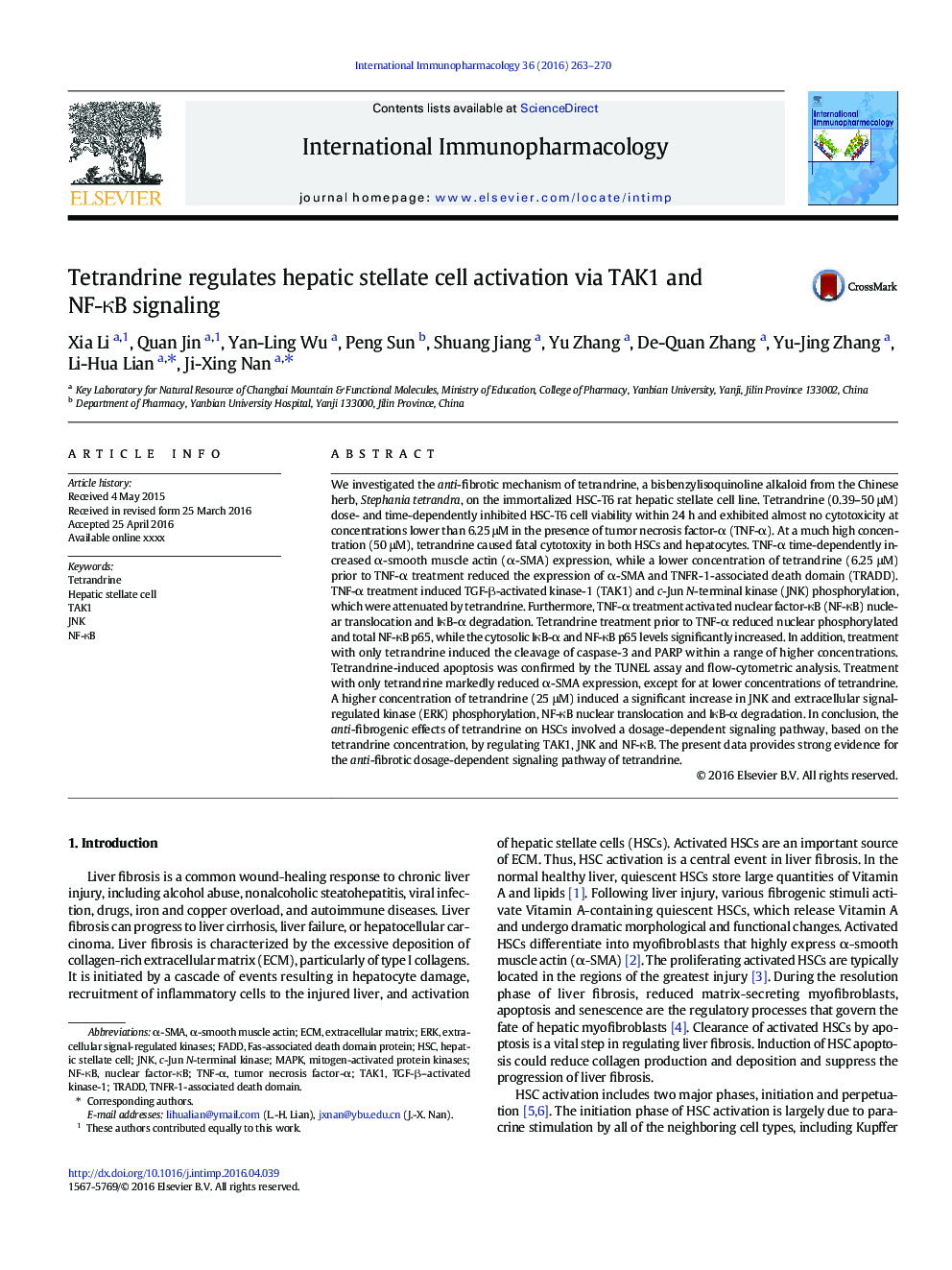| کد مقاله | کد نشریه | سال انتشار | مقاله انگلیسی | نسخه تمام متن |
|---|---|---|---|---|
| 5832017 | 1559754 | 2016 | 8 صفحه PDF | دانلود رایگان |
عنوان انگلیسی مقاله ISI
Tetrandrine regulates hepatic stellate cell activation via TAK1 and NF-κB signaling
دانلود مقاله + سفارش ترجمه
دانلود مقاله ISI انگلیسی
رایگان برای ایرانیان
کلمات کلیدی
ECMNF-κBα-SMAHSCTRADDTAK1JnkERKFADDc-Jun N-terminal kinase - C-Jun N-terminal kinaseMAPK - MAPKα-smooth muscle actin - اکتین عضله آلفا صافtetrandrine - تتراندرینtumor necrosis factor-α - تومور نکروز عامل αHepatic stellate cell - سلول ستاره ای کبدیTNF-α - فاکتور نکروز توموری آلفاnuclear factor-κB - فاکتور هسته ای κBExtracellular matrix - ماتریکس خارج سلولیFAS-associated death domain protein - پروتئین دامنه مرگ مرتبط با FASextracellular signal-regulated kinases - کیناز های تنظیم شده سیگنال خارج سلولیmitogen-activated protein kinases - کیناز پروتئین فعال Mitogen
موضوعات مرتبط
علوم زیستی و بیوفناوری
ایمنی شناسی و میکروب شناسی
ایمونولوژی
پیش نمایش صفحه اول مقاله

چکیده انگلیسی
We investigated the anti-fibrotic mechanism of tetrandrine, a bisbenzylisoquinoline alkaloid from the Chinese herb, Stephania tetrandra, on the immortalized HSC-T6 rat hepatic stellate cell line. Tetrandrine (0.39-50 μM) dose- and time-dependently inhibited HSC-T6 cell viability within 24 h and exhibited almost no cytotoxicity at concentrations lower than 6.25 μM in the presence of tumor necrosis factor-α (TNF-α). At a much high concentration (50 μM), tetrandrine caused fatal cytotoxity in both HSCs and hepatocytes. TNF-α time-dependently increased α-smooth muscle actin (α-SMA) expression, while a lower concentration of tetrandrine (6.25 μM) prior to TNF-α treatment reduced the expression of α-SMA and TNFR-1-associated death domain (TRADD). TNF-α treatment induced TGF-β-activated kinase-1 (TAK1) and c-Jun N-terminal kinase (JNK) phosphorylation, which were attenuated by tetrandrine. Furthermore, TNF-α treatment activated nuclear factor-κB (NF-κB) nuclear translocation and IκB-α degradation. Tetrandrine treatment prior to TNF-α reduced nuclear phosphorylated and total NF-κB p65, while the cytosolic IκB-α and NF-κB p65 levels significantly increased. In addition, treatment with only tetrandrine induced the cleavage of caspase-3 and PARP within a range of higher concentrations. Tetrandrine-induced apoptosis was confirmed by the TUNEL assay and flow-cytometric analysis. Treatment with only tetrandrine markedly reduced α-SMA expression, except for at lower concentrations of tetrandrine. A higher concentration of tetrandrine (25 μM) induced a significant increase in JNK and extracellular signal-regulated kinase (ERK) phosphorylation, NF-κB nuclear translocation and IκB-α degradation. In conclusion, the anti-fibrogenic effects of tetrandrine on HSCs involved a dosage-dependent signaling pathway, based on the tetrandrine concentration, by regulating TAK1, JNK and NF-κB. The present data provides strong evidence for the anti-fibrotic dosage-dependent signaling pathway of tetrandrine.
ناشر
Database: Elsevier - ScienceDirect (ساینس دایرکت)
Journal: International Immunopharmacology - Volume 36, July 2016, Pages 263-270
Journal: International Immunopharmacology - Volume 36, July 2016, Pages 263-270
نویسندگان
Xia Li, Quan Jin, Yan-Ling Wu, Peng Sun, Shuang Jiang, Yu Zhang, De-Quan Zhang, Yu-Jing Zhang, Li-Hua Lian, Ji-Xing Nan,